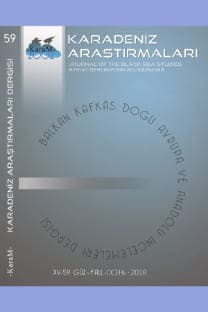SOVYET MİLLİYET POLİTİKASI: ABHAZYA VE GÜNEY OSETYA'DAKİ ETNİK ÇATIŞMA ÜZERİNDEKİ ETKİSİ
Bu çalışmanın amacı, Gürcistan’daki etnik çatışmayla ilgili birbiriyle bağlantılı iki soruyu cevaplamaktır. 1990’ların başlarında, Gürcistan’daki iki etnik grup Gürcistan ortak çatısı altında yaşamak yerine, “neden” ve “nasıl” ayrılıkçı siyaset izlemiş ve bunun sonunda merkezi yönetimle kanlı etnik çatışmalara girişerek bağımsızlıklarını tek taraflı ilan etmişlerdir? Bu çalışmanın ana savı, Sovyetlerin milletler sorununu çözmek için geliştirdikleri “Sovyet milliyet politikası”nın Gürcistan’daki etnik grup olma bilinci oluşturan ve buna paralel olarak etnik çatışmaya zemin hazırlayan temel ve başlıca tetikleyici araçlardan biri olduğunu ispatlamaktır. Bu minvalde, Abhazların ve Güney Osetlerin giriştikleri siyasi statü mücadelesi, Lenin yönetimiyle başlayıp Gorbachev yönetimine kadar değişiklik geçirip evrilen Sovyet millet politikası azınlık gruplarına kendi etnik kimliklerini, dillerini ve kültürlerini geliştirecek, daha da önemlisi kendi kendini yönetme ve ulus olma bilinci kazandıracak ayrıcalıklar tanımıştır. Sovyet millet politikası ve Sovyet federal yapısının doğal sonucu olarak birçok etnik ve bölgesel temelli özerk yönetim yapıları oluşturulmuş, Sovyetler zamanı boyunca bu özerk yapılar kendilerine ait siyasi kurumlarını, ulusal aydın sınıflarını ve bürokratik elitlerini oluşturup geliştirmiş, daha sonra bu sınıflar milliyetçi hareketleri şekillendirmiş ve bunun doğal sonucu olarak da kendi kendini yönetme isteği ve tam bağımsızlık arzusu gelişmiştir. Bunların akabinde, Sovyet sonrası dönemde Gürcistan’daki etnik çatışmalar kaçınılmaz olmuştur.
SOVIET NATIONALITY POLICY: IMPACT ON ETHNIC CONFLICT IN ABKHAZIA AND SOUTH OSSETIA
This study aims to answer two interlinked questions with respect to ethnic conflict in Georgia: (1) Why and how two ethnic groups -the Abkhazians and Ossetians- sought secession in the 1990s rather than accepting unity under a common Georgian roof? (2) what explains the occurrence of ethnic conflicts between the Abkhazians and Georgians and between the South Ossetians and Georgians? The central argument of this paper is that Soviet nationality policy was a foremost driving force in shaping consciousness of being ethnic groups in Georgia and set the stage for the inter-ethnic conflicts of the post-Soviet era. A number of factors explain the particular inter- ethnic conflicts in Georgia among ethnic groups, including a long historical relationship between the Georgian people and the Abkhaz and Ossetian minorities. However, I argue that the foremost factor was the role of Soviet nationality policy that evolved from Lenin to Gorbachev, a policy that granted ethnic groups some level of privileges and fostered a wave of national self-assertion, Soviet nationality policy and the Soviet federal structure created numerous ethnic- and territorial-based autonomous units during the Soviet era. These units shaped their own political institutions, national intelligentsias, and bureaucratic elites, forming the basis for later nationalistic movements and developing a wish for self-determination and full independence. These institutions and beliefs made ethnic conflict in post-Soviet Georgia inevitable.
___
- BREMMER, I. (1993). “Reassessing Soviet Nationalities Theory”. Nations and Politics in the Soviet Successor States: 3-26.
- BRUBAKER, R. (1998). “Myths and Misconceptions in the Study of Nationalism”. (ed. J. A. Hall). The State of the Nation: Ernest Gellner and the Theory of Nationalism. Cambridge University Press: 272-306.
- CORNELL, S. E. (2001). Small Nations and Great Powers: A Study of Ethnopolitical Conflict in the Caucasus. United Kingdom: RoutledgeCurzon.
- CORNELL, S. E. (2002). “Autonomy as a Source of Conflict: Caucasian Conflicts in Theoretical Perspective”. World Politics. LIV/2: 245-276.
- COTTER, J. M. (1999). “Cultural Security Dilemmas and Ethnic Conflict in Georgia”. Journal of Conflict Studies. XIX/1: 1-27.
- FOWKES, B. (2002). Ethnicity and Ethnic Conflict in the Post-Communist World. New York: Palgrave.
